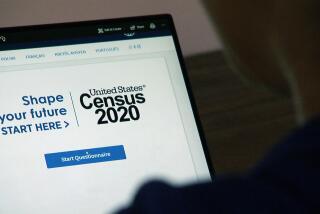Q. What Causes Anger? A. Long Form of Census
- Share via
WASHINGTON — There are the real estate questions: Do you have a mortgage or two? What are your monthly payments?
The job questions: How much did you earn last year? How many weeks did you work? Even plumbing questions: Do you have a flush toilet? Do you have a kitchen sink with piped water?
The U.S. Census Bureau would like answers to 53 such questions from the 20 million randomly selected households that received the so-called long form.
Five times as many got the eight-question short form, which sticks to the basics: name, age, gender and race or ethnicity.
Ideally, the government hopes all forms will be mailed by today, Census Day, which is set by law as the day on which the government attempts, as nearly as possible in a mobile society, to determine how many Americans there are and where they live.
(In reality, forms will be processed if the government gets them by April 11.)
In the next phase of the 22nd national census, an army of enumerators will fan out across the country in an attempt to pry loose answers from those who failed to respond.
What the counters will face are millions of people who often do not understand how the questions they are asked, especially on the long form, reflect the census’ evolving role as the dominant statistical engine driving decisions made by public agencies and private enterprise.
“So many people say, ‘Why is the Census Bureau asking this?’ ” said Terri Ann Lowenthal, a census consultant who worked on the 1990 count for congressional Democrats. “The most important reason is that we need to make decisions based on sound information. A government, or even a private corporation, can’t make decisions involving billions if not trillions of dollars in a vacuum.”
Among those who found questions on the long form to be too much were Barbara and Art Woods. The couple, retired farmers who live in the town of Marlette on Michigan’s rural upper peninsula, got their long form in the mail in mid-March. So did Barbara’s mother, son and sister, all of whom live nearby. Of immediate family who live in the area, only her daughter was sent the short form.
“We have all been discussing it and how unhappy we are,” said Barbara Woods, 54. “I’m all in favor of filling out census forms. I don’t have a problem with it. But when it comes to asking things about income, I don’t think that’s any of their business. They’re prying.”
The origins of the census lie in the constitutional mandate for a decennial head count to reapportion the House of Representatives. For that job, and for the equally vital task of redrawing legislative boundaries within states, census critics rightly note that the short form alone would suffice.
But the government rarely has been able to resist the chance to learn more about its people. In the 19th century, Americans first were asked about their occupations, their education and their immigration status. In 1940, as the country was struggling to emerge from the Great Depression, the government first devised the long form--in essence, a statistical sample--to learn about income, housing and migration patterns. The plumbing question dates from that time, when many people did not have toilets or running water. Even today, some don’t.
In modern America it is the long form that produces the data that help determine where to build the next school or highway, how many stops to put on the new subway, how many Medicare or Medicaid dollars to send to a state or county and countless other decisions of public interest. Government reports on the labor force, fair-market rents, poverty rates and inflation all rely in part on long-form data.
Overall, the government has calculated that more than $180 billion a year in federal aid to the states is guided in part by census data, much of it obtained from the long form.
In the private sector, long-form data that companies obtain from the Census Bureau is an essential platform for the strategic planning of many businesses and nonprofit agencies.
Think of it this way: All those gourmet coffee bars don’t sprout by accident in affluent neighborhoods. Long-form income data can help pinpoint probable clusters of latte-loving yuppies. It can even help find places where yuppies with a long commute would want to get their lattes in a drive-through pit stop instead of a walk-in shop.
And charities that deliver hot meals to the needy are guided in part by long-form data that show where elderly people with disabilities live.
Still, many Americans remain dubious about answering all those questions. These skeptics care little that this year’s long form is actually shorter than its 1990 predecessor by about six questions, that it takes an estimated 38 minutes to complete (five fewer than the last one) and that the government is laying plans for an ongoing demographic survey in the next decade that could make the long form obsolete by 2010. What matters to them now is that they are staring at a 40-page form for the head of the household and wondering why in the world they were singled out.
Consider Mike Neely of Los Angeles, himself a census booster, active in efforts to get a thorough count of the homeless. He got the long form. As Neely put it: “When you first pick it up and look at this thing, it’s like: ‘Oh, my God.’ That was my first impression, ‘Oh, man.’ ”
Earlier this week, angry words about the long form were flying in Washington. Several prominent Republicans, including Senate Majority Leader Trent Lott (R-Miss.), suggested that people who found some of the queries too intrusive should send it in with some answers left blank.
Democrats responded that it was a matter of social justice to urge Americans to fill out the form completely and send it in promptly. They pointed out that individual responses to census questions are by law confidential for 72 years. And they noted that questions are all mandated by statutes and court decisions and that the development of the long form was overseen by the Republican-controlled Congress. One question, in fact, was added by a requirement of the 1996 welfare law, a GOP legislative triumph.
Politicians jumped into the fray, of course, because they were hearing from people like Barbara Woods. She called Rep. Dave Camp (R-Mich.) to complain. Woods was referred to Rep. Nick Smith, also a Michigan Republican, who has been critical of the Census Bureau. Smith’s staff told her that she faced a potential $100 fine if she did not answer the questionnaire.
Her solution? Woods said this week that she would mail in the form but, as Lott suggests, leave a few questions blank and risk the consequences. If she does so, the odds that the government will prosecute her are almost zero. She might, however, get a follow-up call from a census-taker attempting to get answers to leftover questions.
Government officials said that it is too early to predict how many people will refuse to answer all or part of the questions on the long form. In 1990, the mail-in response rate to the long form was about 3 in 5--a bit lower than the rate for the short form.
There are not yet any reliable counts of complaints about the long form. Of the 400,000-plus phone calls that the Census Bureau fielded in the peak days of March, spokesman Steve Jost said, about 1 in 50 was to register some type of complaint. But the bureau does not keep track of how many concerned the long form.
John Reeder, a top Southern California census official, said that calls to his office last month reached about 240 a day, with about 10% logging long-form complaints. But Reeder, who is working on his fourth census, said that such complaints appear to be fewer this time.
In fact, the angriest call Reeder fielded was from someone who didn’t get the long form and wanted one. The caller said that he wanted to tell the government he was disabled--a subject addressed by questions 16 and 17 of the long form. Reeder said he tried to explain that the government would calculate the disabled population by using the long-form sample. But the caller told Reeder what he could do with his sample.
For a wholly unscientific gauge of one sector of popular opinion--people who listen to conservative talk radio--check out Ray Appleton’s show on station KMJ in Fresno. “They’re calling from all four corners. They hate it. Those people who have gotten the long form find it intrusive, unconstitutional and they don’t really want to cooperate,” Appleton said.
One day last month, Appleton took a call from George P. Radanovich, a listener in Mariposa County. Radanovich, who also happens to be a Republican congressman, said that he and his wife, Ethie, had received the long form and were dubious about several questions they deemed intrusive. They had assumed the once-a-decade exercise would be a simple national head count.
But then census workers caught wind of his remarks and reminded Radanovich that data gleaned from those questions would steer federal funding toward his Central Valley district for many popular programs in the decade to come. Those are words that will make any politician’s ears prick up.
Now, a chastened Radanovich says, “I insist that everybody fill out the census forms and be counted.”
(BEGIN TEXT OF INFOBOX / INFOGRAPHIC)
Census Long-Form Questions
About 20 million randomly selected households have received the 53-question U.S. census long form. Some respondents are offended by several questions, shown below:
Source: U.S. Census Bureau
More to Read
Inside the business of entertainment
The Wide Shot brings you news, analysis and insights on everything from streaming wars to production — and what it all means for the future.
You may occasionally receive promotional content from the Los Angeles Times.










